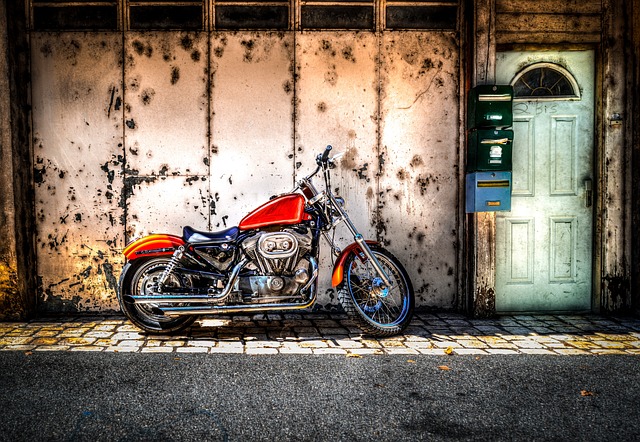Maintaining a motorcycle's battery terminals is crucial for the bike's electrical system's performance and longevity. Corrosion on battery terminals, often identified by a white, green, or blue powdery substance, can disrupt electrical flow leading to starting issues and erratic engine behavior. Regular cleaning of the terminals with a baking soda solution or a specialized cleaner is essential to remove this corrosion and ensure consistent power delivery from the battery to the motorcycle's systems. This upkeep not only prevents disruptions in the bike's electrical functions but also safeguards against the risk of being stranded due to battery failure. Motorcyclists should regularly inspect terminals, clean them as needed, and use a dielectric grease or protectant after cleaning to shield against future corrosion. Employing a battery tender or maintainer is particularly important in colder climates to maintain charge levels. Regular checks and tightening of connections, along with using a battery with the correct electrolyte, contribute to a motorcycle's electrical system running efficiently for an extended period.
Maintaining a motorcycle’s performance hinges on various components, with the battery and its terminals playing a pivotal role. A clean connection at the terminals is crucial for optimal battery function, ensuring a reliable start every time. This article delves into the necessity of regularly cleaning motorcycle battery terminals, shedding light on their role, recognizing signs of corrosion, and providing a detailed guide to restoration. By understanding the long-term benefits and embracing maintenance tips, riders can safeguard their motorcycle’s battery health, enhancing overall ride quality and longevity.
- The Role of Battery Terminals in Motorcycle Functionality
- Identifying Signs of Corroded Terminals on a Motorcycle Battery
- Step-by-Step Guide to Cleaning Motorcycle Battery Terminals
- Long-Term Benefits and Maintenance Tips for Motorcycle Battery Health
The Role of Battery Terminals in Motorcycle Functionality

In a motorcycle, the battery is the linchpin that ignites the engine and powers various electrical components, from the headlight to the electronic fuel injection system. At the heart of this power delivery system are the battery terminals—the points where the battery connects to the motorcycle’s electrical circuit. These terminals, particularly the positive and negative ones, are critical for a reliable electrical connection. The positive terminal facilitates the flow of current from the battery to the ignition system, while the negative terminal completes the circuit to the engine and other components. Over time, these terminals can corrode due to exposure to moisture and airborne contaminants, which can degrade their performance. A buildup of corrosion can lead to poor connections, resulting in a weak electrical signal that could prevent the motorcycle from starting or cause erratic behavior in the electrical system. Regular cleaning of the battery terminals is essential for maintaining optimal functionality and ensuring the longevity of the battery and other connected electrical components. Using a combination of baking soda and water to clean the terminals, followed by a thorough rinsing and drying, can effectively remove corrosion and restore the connections’ integrity. This maintenance step not only ensures the safety and reliability of the motorcycle but also contributes to its overall efficiency and performance. Thus, the role of cleaning motorcycle battery terminals is not just a routine task; it is an integral part of maintaining the health and longevity of your motorcycle’s electrical system.
Identifying Signs of Corroded Terminals on a Motorcycle Battery

Regular maintenance is key to ensuring your motorcycle operates smoothly, and one critical aspect of this upkeep involves checking and cleaning your motorcycle battery terminals. Over time, exposure to the elements or normal operation can lead to corrosion on the terminals, which includes the positive and negative posts as well as the connectors that link the battery to the motorcycle’s electrical system. This corrosion manifests as a white, green, or blue powdery substance around the terminals and cables. It’s a natural byproduct of the chemical reactions that occur within a lead-acid battery, which is the most common type used in motorcycles.
Identifying signs of corroded terminals early on is crucial for maintaining your motorcycle’s electrical system efficiency. A simple visual inspection can reveal if there’s an accumulation of corrosion. If you notice any discoloration or a fuzzy, powdery build-up around the battery posts and connections, it’s time to address this issue. Corroded terminals can cause poor connections, which may result in a weak electrical flow or even prevent the motorcycle from starting. The voltage drop across a corroded connection can lead to erratic engine performance or difficulty in charging the battery properly. Therefore, it’s essential to clean the terminals and cables using a mixture of baking soda and water, or a specialized battery cleaning solution, followed by thorough rinsing and drying. Using a soft brush to gently scrub away the corrosion can restore the connection’s integrity. Regularly checking your motorcycle battery terminals for signs of corrosion will help ensure that your bike starts reliably and that all electrical components function as intended.
Step-by-Step Guide to Cleaning Motorcycle Battery Terminals

When maintaining your motorcycle, cleaning the battery terminals is a critical step to ensure optimal performance and longevity of your bike’s electrical system. Over time, corrosion can build up on the terminals, leading to poor connections and potential starting issues. Here’s a straightforward guide to effectively clean your motorcycle’s battery terminals:
1. Preparation: Before you begin, ensure you have all the necessary tools within reach: a wire brush, gloves to protect your hands, eye protection, baking soda, a small container for mixing, a soft cloth or paper towels, and a voltage tester. Remove the battery cover and any cables connected to the terminal you’re going to clean. Use the voltage tester to confirm that there is no charge in the terminals to prevent any electrical hazards.
2. Cleaning Process: Begin by gently brushing away any loose corrosion from the terminals and battery casing with the wire brush. Mix a paste of baking soda and water until it has a consistent, spreadable consistency. Apply this mixture to the corroded areas using the cloth or paper towels, ensuring full coverage of the corrosion. Let it sit for about 5-10 minutes to loosen the corrosion. Afterward, rinse the terminals with clean water to remove the baking soda paste, being careful to avoid short circuits. Dry the terminals thoroughly with a clean, soft cloth. Once dry, apply a thin layer of dielectric grease or battery terminal protectant to the posts and connectors to prevent future corrosion. Reattach any cables, replace the battery cover, and you’re done. Regular maintenance of your motorcycle battery terminals through this process will help maintain the reliability and efficiency of your bike’s electrical system.
Long-Term Benefits and Maintenance Tips for Motorcycle Battery Health

Regular upkeep and maintenance of your motorcycle’s battery are paramount for ensuring its longevity and reliability, especially when it comes to the functionality of the battery terminals. Over time, corrosion can form on the terminals due to the electrolyte reaction with the air. This corrosion is not only unsightly but also interrupts the flow of electricity between the battery and the motorcycle’s electrical system. By cleaning the battery terminals regularly, you prevent this disruption and ensure a solid connection that can significantly extend the life of your motorcycle battery. Clean terminals mean a more efficient charging process and better performance, which translates to a smoother ride and less likelihood of being stranded due to a dead battery. Additionally, clean terminals help in preventing overcharging as the charging system accurately measures the voltage. From a maintenance perspective, it’s advisable to check the battery level monthly and ensure the charge is above 50% for optimal performance. Regularly inspect the battery case and terminals for cracks or corrosion, and tighten any loose connections to prevent electrical loss. Using a battery tender or maintainer during off-ride periods can also help preserve the battery’s charge and extend its life, especially in colder climates where self-discharge is more pronounced. Taking these proactive steps will not only save you from the inconvenience of a flat battery but also contribute to a safer and more enjoyable motorcycling experience.
Regular maintenance of a motorcycle’s battery terminals is pivotal for the bike’s performance and reliability. As detailed in this article, understanding the role these components play, recognizing the signs of corrosion, and following a straightforward cleaning process are key to extending the life of your motorcycle battery. By adhering to the maintenance tips provided, riders can ensure their batteries operate at peak efficiency, thereby safeguarding against unexpected electrical issues that could hinder their journey. Keeping motorcycle battery terminals clean is not just a preventive measure but an essential aspect of motorcycle upkeep that should be a part of every owner’s routine care regimen.
